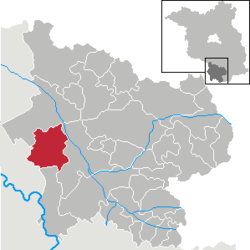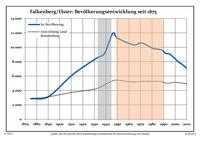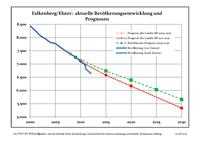Falkenberg is a town in the Elbe-Elster district, in southwestern Brandenburg, Germany. It is situated near the river Schwarze Elster, 16 km east of Torgau, and 13 km northwest of Bad Liebenwerda.
History
It was first mentioned in 1251. In 1547 the Battle of Mühlberg was decided in the vicinity of Falkenberg when the Saxon prince-elector Johann Friedrich I. was taken prisoner. The village itself remained of low importance until the 19th century. The manor changed hands several times, until it was bought by the municipality in 1911. In 1848 Falkenberg got a station on the railway Jüterbog - Riesa. The railway Leipzig/Halle - Eilenburg - Cottbus was opened in 1872 and crossed the former at Falkenberg which became a major junction and grew considerably. Industry and businesses were established, including a power station. World War II caused major destruction. In 1962 Falkenberg was awarded town privileges. The coat of arms reflects the major branches of economy in the town: energy supply, railway, and agriculture.
Large numbers of derelict steam locomotives are stored at an old railway depot just to the north-east.
Demography
-
Development of Population since 1875 within the Actual Boundaries (Blue Line: Population; Dotted Line: Comparison to Population Development of Brandenburg state; Grey Background: Time of Nazi rule; Red Background: Time of Communist rule)
-
Recent Population Development (Blue Line) and Forecasts
Falkenberg/Elster:
Population development within the current boundaries[2]
| Year |
Population |
|
|
|---|
| 1875 | 2 850 |
| 1890 | 3 120 |
| 1910 | 6 031 |
| 1925 | 7 763 |
| 1933 | 8 578 |
| 1939 | 9 194 |
| 1946 | 11 941 |
| 1950 | 11 273 |
| 1964 | 10 346 |
| 1971 | 10 596 |
|
|
| Year |
Population |
|
|
|---|
| 1981 | 9 827 |
| 1985 | 9 749 |
| 1989 | 9 573 |
| 1990 | 9 443 |
| 1991 | 9 271 |
| 1992 | 9 138 |
| 1993 | 9 131 |
| 1994 | 9 091 |
| 1995 | 9 064 |
| 1996 | 8 974 |
|
|
| Year |
Population |
|
|
|---|
| 1997 | 8 854 |
| 1998 | 8 689 |
| 1999 | 8 554 |
| 2000 | 8 435 |
| 2001 | 8 262 |
| 2002 | 8 075 |
| 2003 | 7 953 |
| 2004 | 7 819 |
| 2005 | 7 768 |
| 2006 | 7 627 |
|
|
| Year |
Population |
|
|
|---|
| 2007 | 7 497 |
| 2008 | 7 378 |
| 2009 | 7 254 |
| 2010 | 7 098 |
| 2011 | 6 812 |
| 2012 | 6 650 |
|
|
Detailed data sources are to be found in the Wikimedia Commons.[3]
References
Towns and municipalities in Elbe-Elster |
|---|
|
- Bad Liebenwerda
- Crinitz
- Doberlug-Kirchhain
- Elsterwerda
- Falkenberg/Elster
- Fichtwald
- Finsterwalde
- Gorden-Staupitz
- Gröden
- Großthiemig
- Heideland
- Herzberg (Elster)
- Hirschfeld
- Hohenbucko
- Hohenleipisch
- Kremitzaue
- Lebusa
- Lichterfeld-Schacksdorf
- Massen-Niederlausitz
- Merzdorf
- Mühlberg
- Plessa
- Röderland
- Rückersdorf
- Sallgast
- Schilda
- Schlieben
- Schönborn
- Schönewalde
- Schraden
- Sonnewalde
- Tröbitz
- Uebigau-Wahrenbrück
| |
|




